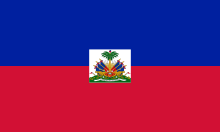HAITI
 Haiti belongs to the Greater Antilles. It is the western part of Hispaniola ; the eastern part is the Dominican Republic. A 388-km-long frontier divides the two republics. Haiti has several islands : Gonâve island (Île de la Gonâve) situated off Port-of-Prince, the capital ; Cow Island (Île-à-Vache) located at 15km south in Baie des Cayes ; Turtle Island (Île de la Tortue), in the north. The country’s area is 27 750 sq km.
Haiti belongs to the Greater Antilles. It is the western part of Hispaniola ; the eastern part is the Dominican Republic. A 388-km-long frontier divides the two republics. Haiti has several islands : Gonâve island (Île de la Gonâve) situated off Port-of-Prince, the capital ; Cow Island (Île-à-Vache) located at 15km south in Baie des Cayes ; Turtle Island (Île de la Tortue), in the north. The country’s area is 27 750 sq km.
Several ranges of mountains occupy the territory : Montagnes du Nord-Ouest ; Chaîne de Vallières, in the north-east ; Montagnes Noires and Chaîne des Matheux, in the middle ; Massif de la Hotte, in the south-east with its highest point, Pic Macaya (2347m) ; Massif de la Selle in the south-east where is Haiti’s tallest mountain, Pic de la Selle (2674m). Unfortunately, only a small portion of virgin forests survives, the rest has been destroyed for agriculture and fuel wood.
The largest river is The Artibonite that runs 400 km through the centre of the country.
Over 200 species of bird nest in the island ; the gray-crowned palm tanager is an endemic species to Haiti. In the coastal waters, there is a colony of manatees and some turtles. American crocodiles live in Étang Saumâtre which is situated at the centre of the country. Iguanas also belong to the wildlife.
Market gardening (bananas, rice…) and fishing are the base of the economy. Coffee, sugar and cocoa are exported. In times past flourishing, tourism has declined but the government tries to boost it. The mining exploitation and the industry are low.
This land was discovered in 1492 by Christopher Columbus who named it Hispaniola. The Spaniards colonized the eastern part of the island. At that time, the island was inhabited by Amerindians – the Tainos – who came from Venezuela by canoes around 2600 BC. Thirty years after the Spaniards’ landing (around 1520), the population of 400 000 Tainos had disappeared. Some of them ran away, other died by desease, abuse and suicide. Then, the Spanish settlers turned to Africa to get slaves for their sugar cane plantations. The French colonists settled in the western half part of the island in the 17th century and appropriated officially this area in 1697 by the Treaty of Ryswick. In 1731, the Spanish recognized the French colony known as Saint-Domingue and a frontier was drawn up. This colony became prosperous. In the 18th century, there were 600 000 inhabitants, among them 500 000 were Black slaves.
François Dominique Toussaint Louverture, the Black leader who militated in favor of French Revolution, led to the victory the slaves’ revolt against the settlers (1791- 1794) to get political rights. In 1802, Napoléon Bonaparte restored slavery in the French colonies and sent general Charles Leclerc to re-appropriate the island. Toussaint was deported to France and died in 1803 but Jean-Jacques Dessalines continued the fight and defeated the French general Rochambeau in 1803.
Haiti proclaimed its independence on January 1st, 1804. It restored its Taino name, Haiti, that means “Mountainous Land”. Two years later, Dessalines was assassinated. In 1807, two men shared between themselves the country : in the north, Henri Christophe, king until his death in 1820 ; in the south, Anne Alexandre Pétion, President of the Republic until his death in 1808. Jean-Pierre Boye r succeeded him, annexed the north and the Spanish colony. The Eastern of the island rebeled against Haiti and proclaimed the Dominican Republic in 1844. In 1849, Faustin 1st founded an empire in Haiti which lasted ten years. No leader succeeded in stabilizing the country. The United States intervened militarly in the island in 1915 and stayed there until 1934. Then, in 1964, Haiti experienced the Duvalier’s dictatorships : François, the father, and Jean-Claude, the son. In 1990, Jean-Bertrand Aristide (a catholic priest) was elected president. Next year, the army took the power.
Since then, despite democratic elections and the 2010’s powerful earthquake which killed 300 000 people, Haiti is seeking stability.
Area : 27 750 sq km (10 714 sq miles)
Population : 10,9 million inhabitants
Capital : Port-au-Prince
Languages : French – Creole
Currency : Gourde (HTG)
people : Haitians
